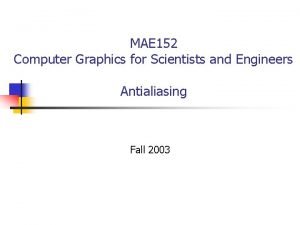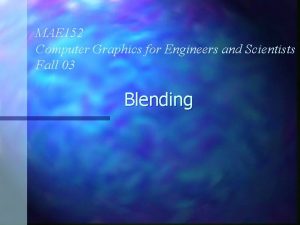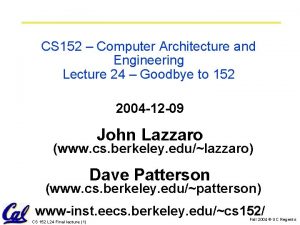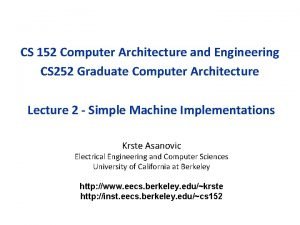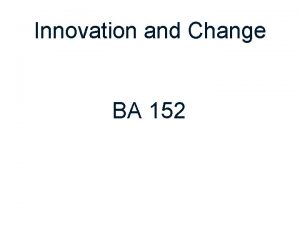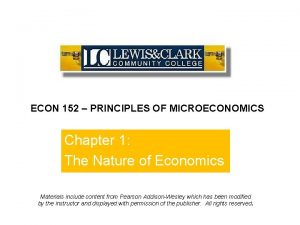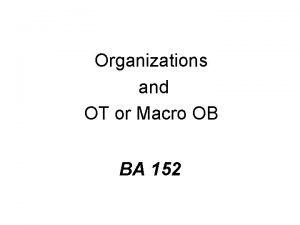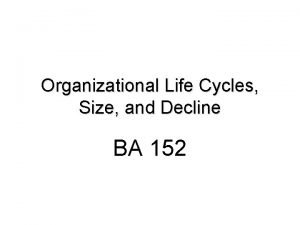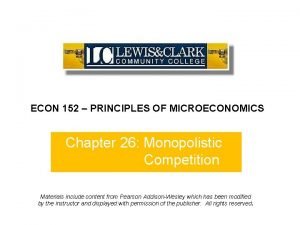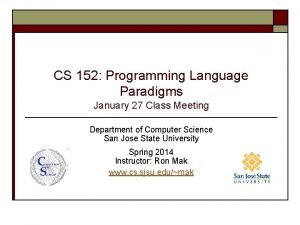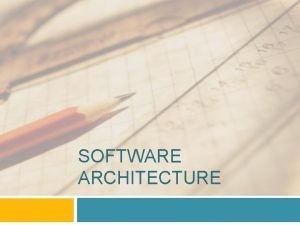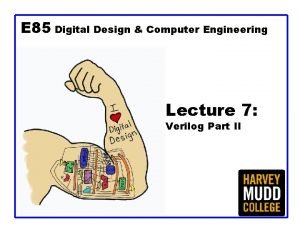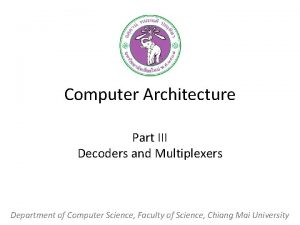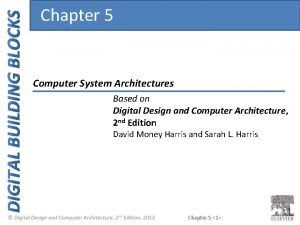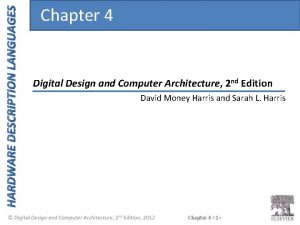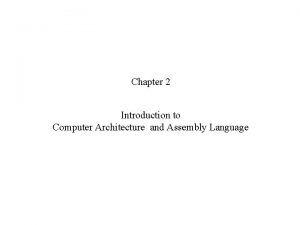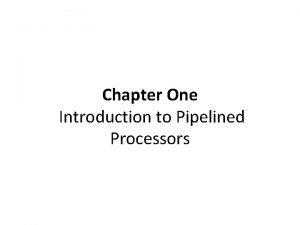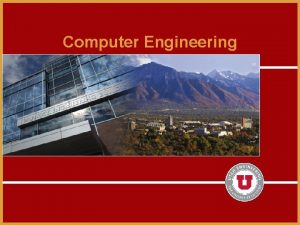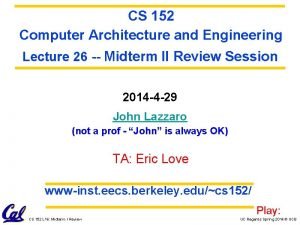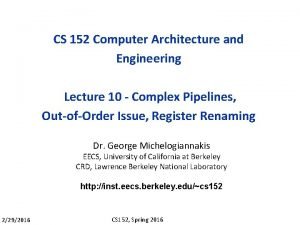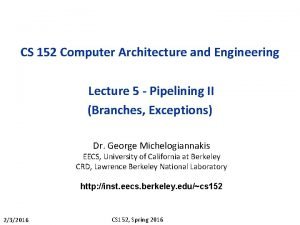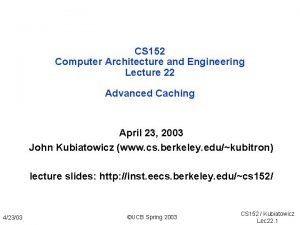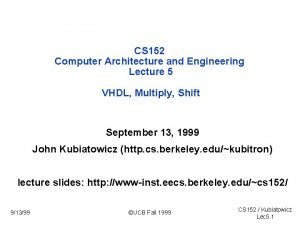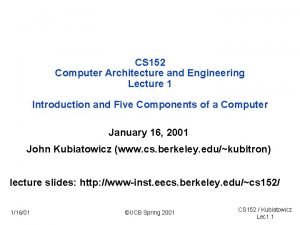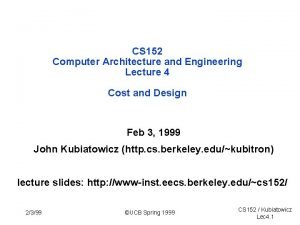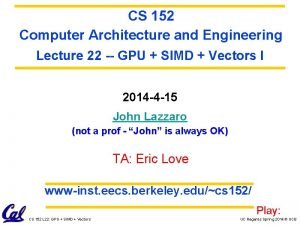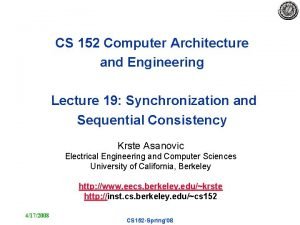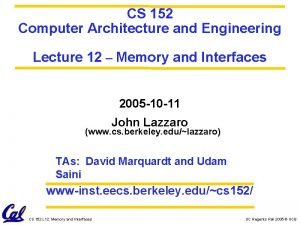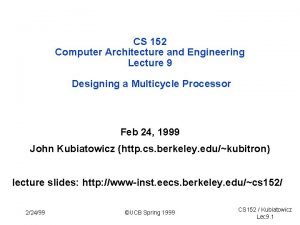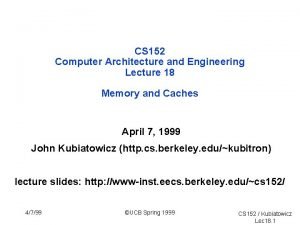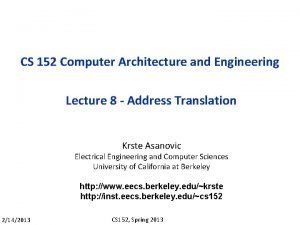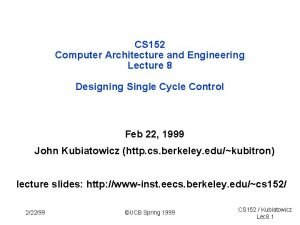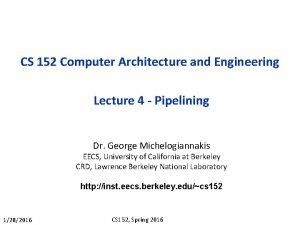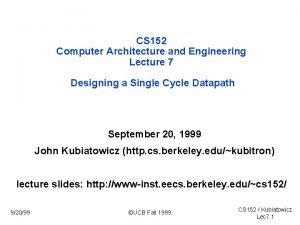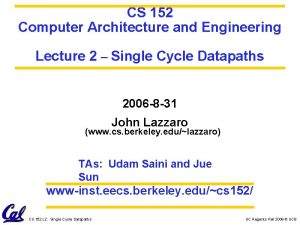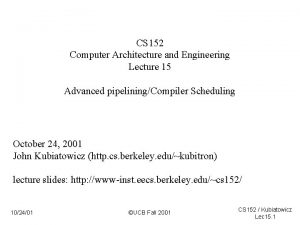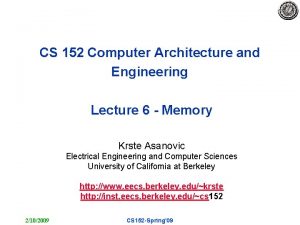CS 152 Computer Architecture and Engineering Lecture 3






















































- Slides: 54

CS 152 Computer Architecture and Engineering Lecture 3 – Single Cycle Wrap-Up + VLIW 2006 -9 -5 John Lazzaro (www. cs. berkeley. edu/~lazzaro) TAs: Udam Saini and Jue Sun www-inst. eecs. berkeley. edu/~cs 152/ CS 152 L 3: Single Cycle Wrap-up UC Regents Fall 2006 © UCB

Last Time: Goal #1, an R-format CPU Syntax: ADD $8 $9 $10 opcode rs Sample program: ADD $8 $9 $10 SUB $4 $8 $3 AND $9 $8 $4. . . How registers get their initial values are not of concern to us right now. CS 152 L 3: Single Cycle Wrap-up Semantics: $8 = $9 + $10 rt rd shamt funct No branches or jumps: machine only runs straight line code. No loads or stores: machine has no use for data memory, only instruction memory. UC Regents Fall 2006 © UCB

Last Time: An R-format CPU design Decode fields to get : ADD $8 $9 $10 opcode rs rt rd shamt funct Logic op 5 5 5 32 Reg. File rs 1 rs 2 ws wd 32 CS 152 L 3: Single Cycle Wrap-up 32 rd 1 rd 2 32 32 A L U 32 WE UC Regents Fall 2006 © UCB

Last Time: Goal #2, I-format instructions Syntax: ORI $8 $9 64 Semantics: $8 = $9 | 64 In this example, $9 is rs and $8 is rt. 16 -bit immediate extended to 32 bits. Zero-extend: 0 x 8000 ⇨ 0 x 00008000 Sign-extend: 0 x 8000 ⇨ 0 x. FFFF 8000 Some MIPS instructions zero-extend immediate field, other instructions sign. CS 152 L 3: Single Cycle Wrap-up UC Regents Fall 2006 © UCB

Last Time: The merged data path. . . opcode rs rt rd shamt funct ALUctr op 5 5 rs 1 rs 2 5 ws wd Reg. Dest 32 Reg. File 32 32 rd 1 rd 2 32 32 WE Ext. Op CS 152 L 3: Single Cycle Wrap-up 32 A L U ALUsrc UC Regents Fall 2006 © UCB

Today’s Lecture: Single-Cycle Wrap-up Design stand-alone machines for other major classes of instructions: branches, load/store. Implementing control structures for the single-cycle datapath. Very Long Instruction Words (VLIW): Doing more work in a single cycle. And also, Design Notebook for Lab CS 152 L 3: Single Cycle Wrap-up UC Regents Fall 2006 © UCB

Memory Instructions CS 152 L 3: Single Cycle Wrap-up UC Regents Fall 2006 © UCB

Loads, Stores, and Data Memory. . . Syntax: LW $1, 32($2) Syntax: SW $3, 12($4) Action: $1 = M[$2 + 32] Action: M[$4 + 12] = $3 32 Zero-extend or sign-extend immediate field? are combinational: Reads Data Memory Addr 32 Dout Put a stable address on Addr, a short time later Dout is ready Din 32 WE Writes are clocked: If WE is high, memory Addr captures Din on positive edge of clock. Note: Not a realistic main memory (DRAM) CS 152 L 3: Single Cycle Wrap-up UC Regents Fall 2006 © UCB

Adding data memory to the data path 5 5 5 Reg. File rs 1 Reg. Dest 32 rd 1 rs 2 ws wd 32 ALUctr rd 2 32 WE Ext Reg. Wr Ext. Op Mem. To. Reg ALUsrc Mem. Wr Load delay slot CPU, or not ? Syntax: LW $1, 32($2) Syntax: SW $3, 12($4) Action: $1 = M[$2 + 32] Action: M[$4 + 12] = $3 CS 152 L 3: Single Cycle Wrap-up UC Regents Fall 2006 © UCB

Branch Instructions CS 152 L 3: Single Cycle Wrap-up UC Regents Fall 2006 © UCB

Conditional Branches in MIPS. . . Syntax: BEQ $1, $2, 12 Action: If ($1 != $2), PC = PC + 4 Action: If ($1 == $2), PC = PC + 48 Immediate field codes # words, not # Why is this encoding bytes. a good idea? Zero-extend or sign-extend immediate field? method a good Why is this extension idea? CS 152 L 3: Single Cycle Wrap-up UC Regents Fall 2006 © UCB

Adding branch testing to the data path 5 5 5 Reg. File rs 1 Reg. Dest 32 rd 1 rs 2 ws wd 32 ALUctr rd 2 32 WE Ext Reg. Wr Ext. Op Mem. To. Reg ALUsrc Mem. Wr Equal (wire into control) Syntax: BEQ $1, $2, 12 Action: If ($1 != $2), PC = PC + 4 Action: If ($1 == $2), PC = PC + 48 CS 152 L 3: Single Cycle Wrap-up UC Regents Fall 2006 © UCB

Recall: Straight-line Instruction Fetch Instr Mem 32 Data Fetching straight-line MIPS instructions requires a machine that generates this timing diagram: Addr 32 CLK Addr PC Data PC + 4 IMem[PC] IMem[PC + 4] PC + 8 IMem[PC + 8] PC == Program Counter, points to next instruction. CS 152 L 3: Single Cycle Wrap-up UC Regents Fall 2006 © UCB

Recall: Straight-line Instruction Fetch How do we add this behavior ? Syntax: BEQ $1, $2, 12 Action: If ($1 != $2), PC = PC + 4 Action: If ($1 == $2), PC = PC + 48 32 PC 32 + Instr Mem 32 32 D Q 32 Addr Data 32 0 x 4 Clk CLK Addr PC Data CS 152 L 3: Single Cycle Wrap-up PC + 4 IMem[PC] IMem[PC + 4] PC + 8 IMem[PC + 8] UC Regents Fall 2006 © UCB

Design: Instruction Fetch with Branch Syntax: BEQ $1, $2, 12 Action: If ($1 != $2), PC = PC + 4 Action: If ($1 == $2), PC = PC + 48 32 PC Instr Mem 32 32 32 D + Q 32 0 x 4 Addr Data 32 32 PCSrc Ex te nd Clk + 32 CS 152 L 3: Single Cycle Wrap-up UC Regents Fall 2006 © UCB

Single-Cycle Control CS 152 L 3: Single Cycle Wrap-up UC Regents Fall 2006 © UCB

What is single cycle control? Instr Mem Combinational Logic (Only Gates, No Flip Flops) Equal 32 Addr Just specify logic functions! Data Reg. Dest PCSrc Reg. Wr Ext. Op rs, rt, rd, imm 5 5 5 ALUsrc Reg. File rs 1 Reg. Dest ALUctr rd 1 ws wd Mem. Wr 32 rs 2 32 Mem. To. Reg rd 2 32 Equal WE Ext Reg. Wr CS 152 L 3: Single Cycle Wrap-up Ext. Op Mem. To. Reg ALUsrc Mem. Wr UC Regents Fall 2006 © UCB

Two goals when specifying control logic Bug-free: One “ 0” that should be a “ 1” in the control logic function breaks contract with the programmer. Should be easy for humans to read and understand: sensible signal names, symbolic constants. . . Efficient: Logic function specification should map to hardware with good performance properties: fast, small, low power, etc. CS 152 L 3: Single Cycle Wrap-up UC Regents Fall 2006 © UCB

In practice: Use behavioral Verilog Advice: Carefully written Verilog will yield identical semantics in Model. Sim and Synplicity. If you write your code in this way, many “works in Modelsim but not on Xilinx” issues disappear. Always check log files, and inspect output tools produce! Look for tell-tale Synplicity “warnings and errors” messages ! “latch generated”, “combinational loop detected” etc Automate with scripts if possible. CS 152 L 3: Single Cycle Wrap-up UC Regents Fall 2006 © UCB

Labs: A small subset of MIPS. . . What if some other instruction appears in the instruction stream? For labs: undefined. CS 152 L 3: Single Cycle Wrap-up Real world: exceptions. UC Regents Fall 2006 © UCB

Why not in labs? Doubles complexity! Components in blue handle exceptions. . . Will cover this (pipelined CPU) CS 152 L 3: Single Cycle Wrap-up UC Regents Fall 2006 © UCB

Lab 2: Learn from the past. . . Compare semantics are tricky! CS 152 L 3: Single Cycle Wrap-up Most project teams fail the Lab 2 checkoff the first time because they did not implement MIPS ISA for these correctly! UC Regents Fall 2006 © UCB

Where we are now, and what is next We know how to map ISA syntax and semantics into single-cycle hardware How to make sure your Lab 2 design implements the ISA correctly. Software for teamwork, group dynamics, etc. . . Top-down view of how signals move through your processor in time. CS 152 L 3: Single Cycle Wrap-up UC Regents Fall 2006 © UCB

Administrivia: Upcoming deadlines. . . Tonight: Lab 1 final report due, 11: 59 PM, via the submit program. To submit the Lab 1 final report: (1) Log into the Windows Terminal Server iserver 2. eecs. berkeley. edu, using RDC (see Resources page) or via other means. (2) Once logged into iserver 2, copy the file m: binsubmit-fall 2006. exe to your desktop (which is on the C: drive). (3) Execute the copied file on your desktop and follow the instructions. At the moment, submit-fall 2006 is only known to work on iserver 2 -- once we know it works on the machines in 125 and 119 Cory we will make an announcement. Refresh Lab 1 Web page to see these CS 152 L 3: Single Cycle Wrap-up UC Regents Fall 2006 © UCB

Administrivia: Upcoming deadlines. . . Tonight: Lab 1 final report due, 11: 59 PM via the submit program. Thursday: Lab 2 preliminary design document due to TAs via email, 11: 59 PM. Friday: “Design Document Review” in section, 125 Cory. Monday: Lab 2 final design document due to TAs via email, 11: 59 PM. CS 152 L 3: Single Cycle Wrap-up UC Regents Fall 2006 © UCB

Office Hours, Mid-terms. . . Udam: MW 6 -7 PM, 125 Cory Jue: TTh 3 -4 PM, 125 Cory John: TTh 10 -11 AM, 315 Soda Mid-term 1: Tuesday October 3 rd, 6: 00 to 9: 00 PM, TBA. Mid-term 2: Tuesday December 5 th, 6: 00 to 9: 00 PM, TBA. Last call for schedule conflicts. . . CS 152 L 3: Single Cycle Wrap-up UC Regents Fall 2006 © UCB

Josh Fisher: idea grew out of his Ph. D (1979) in compilers VLIW Very Long Instruction Words CS 152 L 3: Single Cycle Wrap-up Led to a startup (Multi. Flow) whose computers worked, but which went out of business. . . the ideas remain influential. UC Regents Fall 2006 © UCB

Basic Idea: Super-sized Instructions Example: All instructions are 64 -bit. Each instruction consists of two 32 -bit MIPS instructions, that execute in parallel. Syntax: ADD $8 $9 $10 Semantics: $8 = $9 + $10 opcode rs rt rd shamt funct Syntax: ADD $7 $8 $9 Semantics: $7 = $8 + $9 A 64 -bit VLIW instruction CS 152 L 3: Single Cycle Wrap-up UC Regents Fall 2006 © UCB

VLIW Assembly Syntax. . . Denotes start of an instruction word. Instr: ADD $8 $9 $10 ADD $7 $8 $9 Instr: SUB $2 $3 $0 OR $1 $5 $4 [. . . ] Label: Listed operators all execute in parallel. Execute in parallel AND $5 $2 $3 OR $1 $5 $4 Branch label name instead of default “instr” CS 152 L 3: Single Cycle Wrap-up UC Regents Fall 2006 © UCB

32 -bit & 64 -bit semantics different? Yes! Assume: $7 = 7, $8 = 8, $9 = 9, $10 = 10 (decimal) 32 -bit MIPS: ADD $8 $9 $10; Result: $8 = 19 ADD $7 $8 $9; Result: $7 = 28 VLIW: Instr: ADD $8 $9 $10 ; result $8 = 19 ADD $7 $8 $9 ; result $7 = 17 (not 28) CS 152 L 3: Single Cycle Wrap-up UC Regents Fall 2006 © UCB

Design: A 64 -bit VLIW R-format CPU Syntax: ADD $8 $9 $10 Semantics: $8 = $9 + $10 opcode rs rt rd shamt funct Syntax: ADD $7 $8 $9 Semantics: $7 = $8 + $9 No branches or jumps: machine only runs straight line code. No loads or stores: machine has no use for data memory, only instruction memory. CS 152 L 3: Single Cycle Wrap-up UC Regents Fall 2006 © UCB

VLIW: Straight-line Instruction Fetch Simple changes to support 64 -bit instructions. . . 32 PC 32 + D 32 Q 32 Instr Mem Addr Data 32 64 0 x 8 Clk +8 in hexadecimal -- 64 bit instructions CLK Addr PC Data CS 152 L 3: Single Cycle Wrap-up PC + 8 IMem[PC] PC + 16 IMem[PC + 8] IMem[PC + 16] UC Regents Fall 2006 © UCB

Computing engine of VLIW R-format CPU opcode rs rt rd shamt funct op 32 Reg. File 5 5 5 32 32 rs 1 rs 2 rd 1 ws 1 rd 2 32 32 A L U 32 wd 1 rs 3 rd 3 rs 4 ws 2 wd 2 rd 4 32 32 WE 1 WE 2 op opcode CS 152 L 3: Single Cycle Wrap-up rs rt rd shamt funct UC Regents Fall 2006 © UCB

What have we gained with 64 -bit VLIW? If: Clock speed remains the same. All 32 -bit operators do useful work. Performance doubles! Syntax: ADD $8 $9 $10 Semantics: $8 = $9 + $10 opcode rs rt rd shamt funct Syntax: ADD $7 $8 $9 Semantics: $7 = $8 + $9 N x 32 -bit VLIW yields factor of N speedup! Multiflow: N = 7, 14, or 28 (3 CPUs in product family CS 152 L 3: Single Cycle Wrap-up UC Regents Fall 2006 © UCB

What does N = 14 assembly look like? Two instructions from a scientific benchmark (Linpack) for a Multi. Flow CPU with 14 operations per instruction. CS 152 L 3: Single Cycle Wrap-up UC Regents Fall 2006 © UCB

What have we gained with 64 -bit VLIW? If: A very big “if” ! Clock speed remains the same All 32 -bit operators do useful work. Performance doubles! Syntax: ADD $8 $9 $10 Semantics: $8 = $9 + $10 opcode rs rt rd shamt funct Syntax: ADD $7 $8 $9 Semantics: $7 = $8 + $9 N x 32 -bit VLIW yields factor of N speedup! Multiflow: N = 7, 14, or 28 (3 CPUs in product family CS 152 L 3: Single Cycle Wrap-up UC Regents Fall 2006 © UCB

As N scales, HW and SW needs conflict Software need: All operators do useful work. Application (i. Tunes) Compiler Software Hardware Assembler Operating System (Mac OS X) Processor Memory I/O system Datapath & Control Digital Design Circuit Design Instruction Set Architecture: Where the conflict plays out. Transistors Hardware need: Clock does not slow down. CS 152 L 1: The MIPS ISA UC Regents Fall 2006 © UCB

Example problem: Register file ports. . . N ALUs require 2*N read ports and N write ports. Why is this a problem? op 32 Reg. File 5 5 rs 1 rs 2 rd 1 5 32 ws 1 rd 2 5 5 5 32 32 32 A L U 32 wd 1 rs 3 rd 3 rs 4 ws 2 wd 2 rd 4 WE 1 WE 2 32 32 op CS 152 L 3: Single Cycle Wrap-up UC Regents Fall 2006 © UCB

Recall: Register File Design clk sel(ws) 5 R 0 - The constant 0 D D E WE M U. . . X D En En R 1 R 2 More read ports increases fanout, slows sel(rs 1) down reads. 5 Q 32 . . . Q Q . . . D wd 32 R 31 Q More write ports adds data muxes, demux OR CS 152 L 3: Single Cycle Wrap-up 32 sel(rs 2) 5 32 . . . En M 32 rd 1 U X . . . 32 M 32 rd 2 U X UC Regents Fall 2006 © UCB

Split register files: A solution? Software need: All operators do useful work. Too often, the data an ALU needs to do “useful work” will not be in its own op regfile. Reg. File 5 5 5 rs 1 32 rd 1 rs 2 ws wd 32 32 rd 2 32 32 WE A L U 32 32 5 5 5 Reg. File rs 1 32 rd 1 rs 2 ws wd 32 rd 2 32 32 WE CS 152 L 3: Single Cycle Wrap-up op UC Regents Fall 2006 © UCB

Architect’s job: Find a good compromise Example solution: Split register files, with a dedicated bus and special instructions for moves between regfiles. May hurt software more than it helps hardware : -( Software Hardware Application Compiler Assembler Operating System Processor Memory I/O system Datapath & Control Digital Design Circuit Design CS 152 L 1: The MIPS ISA Transistors Instruction Set Architecture: Where the conflict plays out. UC Regents Fall 2006 © UCB

Branch policy: All instr operators execute BNE $8 $9 Label opcode rs rt ADD $7 $8 $9 rd shamt funct opcode rs rt rd shamt funct ADD executes if branch is taken or not taken. Problem: Large N machines find it hard to fill all operators with useful work. Solution: New “predication” operator. Syntax: SELECT $7 $8 $9 $10 Semantics: If $8 == 0, $7 = $10, else $7 = $9 Permits simple branches to be converted to inline code. CS 152 L 3: Single Cycle Wrap-up UC Regents Fall 2006 © UCB

Branch nesting in a single instruction. . . BEQ $8 $9 Label. One opcode rs rt rd shamt funct BEQ $11 $12 Label. Two Conundrum: How to define the semantics of multiple branches in one instruction? Solution: Nested branch semantics If $8 == $9, branch to Label. One Else $11 == $12, branch to Label. Two Multi. Flow: N-way Branch priority set in an opcode CS 152 L 3: Single Cycle Wrap-up UC Regents Fall 2006 © UCB

Will return to VLIW later in semester. . . CS 152 L 1: The MIPS ISA UC Regents Fall 2006 © UCB

y n a So m work” m “tea , we s c i p to do o t need arly. . . e e n o Design Notebook CS 152 L 3: Single Cycle Wrap-up UC Regents Fall 2006 © UCB

Why should you keep a design notebook? ° Keep track of the design decisions and the reasons behind them • Otherwise, it will be hard to debug and/or refine the design • Write it down so that can remember in long project: 2 weeks ->2 yrs • Others can review notebook to see what happened ° Record insights you have on certain aspect of the design as they come up ° Record of the different design & debug experiments • Memory can fail when very tired ° Industry practice: learn from others mistakes CS 152 L 3: Single Cycle Wrap-up UC Regents Fall 2006 © UCB

Why do we keep it on-line? ° You need to force yourself to take notes • Open a window and leave an editor running: 1) Acts as reminder to take notes 2) Makes it easy to take notes • 1) + 2) => will actually do it ° Take advantage of the window system’s ° “cut and paste” features ° It is much easier to read typing than writing ° Also, paper log books have problems • Limited capacity => end up with many books • May not have right book with you. • Can use computer to search files. CS 152 L 3: Single Cycle Wrap-up UC Regents Fall 2006 © UCB

How to do it? See “Resources” web page ° Keep it simple • DON’T make it too elaborate (fonts, layout, . . . ) ° Separate the entries by dates • type “date” command in another window and cut&paste ° Start day with problems going to work on today ° Record output of simulation into log with cut&paste; add date • May help sort out which version of simulation did what ° Record key email with cut&paste ° Record of what works & doesn’t helps team decide what went wrong after you left ° Index: write a one-line summary of what you did at end of each day CS 152 L 3: Single Cycle Wrap-up UC Regents Fall 2006 © UCB

1 st page of Notebook (Index + Wed. 9/6/95) * Index =============================== Wed Sep 6 00: 47: 28 PDT 1995 - Created the 32 -bit comparator component Thu Sep 7 14: 02: 21 PDT 1995 - Tested the comparator Mon Sep 11 12: 01: 45 PDT 1995 - Investigated bug found by Bart in comp 32 and fixed it + ================================== Wed Sep 6 00: 47: 28 PDT 1995 Goal: Layout the schematic for a 32 -bit comparator I've layed out the schemtatics and made a symbol for the comparator. I named it comp 32. The files are ~/wv/proj 1/sch/comp 32. sch ~/wv/proj 1/sch/comp 32. sym Wed Sep 6 02: 29: 22 PDT 1995 - ================================== • • Add 1 line index at front of log file at end of each session: date+summary Start with date, time of day + goal Make comments during day, summary of work End with date, time of day (and add 1 line summary at front of file) CS 152 L 3: Single Cycle Wrap-up UC Regents Fall 2006 © UCB

2 nd page of Notebook (Thursday 9/7/95) + ================================== Thu Sep 7 14: 02: 21 PDT 1995 Goal: Test the comparator component I've written a command file to test comp 32. in ~/wv/proj 1/diagnostics/comp 32. cmd. I've placed it I ran the command file in viewsim and it looks like the comparator is working fine. I saved the output into a log file called ~/wv/proj 1/diagnostics/comp 32. log Notified the rest of the group that the comparator is done. Thu Sep 7 16: 15: 32 PDT 1995 - ================================== CS 152 L 3: Single Cycle Wrap-up UC Regents Fall 2006 © UCB

3 rd page of Notebook (Monday 9/11/95) + ================================== Mon Sep 11 12: 01: 45 PDT 1995 Goal: Investigate bug discovered in comp 32 and hopefully fix it Bart found a bug in my comparator component. He left the following e-mail. ---------From bart@simpsons. residence Sun Sep 10 01: 47: 02 1995 Received: by wayne. manor (NX 5. 67 e/NX 3. 0 S) id AA 00334; Sun, 10 Sep 95 01: 47: 01 -0800 Date: Wed, 10 Sep 95 01: 47: 01 -0800 From: Bart Simpson <bart@simpsons. residence> To: bruce@wanye. manor, old_man@gokuraku, hojo@sanctuary Subject: [cs 152] bug in comp 32 Status: R Hey Bruce, I think there's a bug in your comparator. The comparator seems to think that ffff and fffffff 7 are equal. Can you take a look at this? Bart -------- CS 152 L 3: Single Cycle Wrap-up UC Regents Fall 2006 © UCB

4 th page of Notebook (9/11/95 contd) I verified the bug. here's a viewsim of the bug as it appeared. . (equal should be 0 instead of 1) ---------SIM>stepsize 10 ns SIM>v a_in A[31: 0] SIM>v b_in B[31: 0] SIM>w a_in b_in equal SIM>a a_in ffffh SIM>a b_in fffffff 7h SIM>sim time = 10. 0 ns A_IN=FFFFH B_IN=FFFFFFF 7H EQUAL=1 Simulation stopped at 10. 0 ns. ---------Ah. I've discovered the bug. I mislabeled the 4 th net in the comp 32 schematic. I corrected the mistake and re-checked all the other labels, just in case. I re-ran the old diagnostic test file and tested it against the bug Bart found. It seems to be working fine. hopefully there aren’t any more bugs: ) CS 152 L 3: Single Cycle Wrap-up UC Regents Fall 2006 © UCB

5 th page of Notebook (9/11/95 continued) On second inspectation of the whole layout, I think I can remove one level of gates in the design and make it go faster. But who cares! the comparator is not in the critical path right now. the delay through the ALU is dominating the critical path. so unless the ALU gets a lot faster, we can live with a less than optimal comparator. I e-mailed the group that the bug has been fixed Mon Sep 11 14: 03: 41 PDT 1995 - ================================== • Perhaps later critical path changes; what was idea to make comparator faster? Check log book! CS 152 L 3: Single Cycle Wrap-up UC Regents Fall 2006 © UCB

Where we are now, and what is next We know how to map ISA syntax and semantics into single-cycle hardware How to make sure your Lab 2 design implements the ISA correctly. Software for teamwork, group dynamics, etc. . . Top-down view of how signals move through your processor in time. Good luck with Lab 1 ! CS 152 L 3: Single Cycle Wrap-up UC Regents Fall 2006 © UCB
 Computer architecture notes
Computer architecture notes Microarchitecture vs isa
Microarchitecture vs isa 01:640:244 lecture notes - lecture 15: plat, idah, farad
01:640:244 lecture notes - lecture 15: plat, idah, farad Difference between computer organization and architecture
Difference between computer organization and architecture Bus design in computer architecture
Bus design in computer architecture What is system design in software engineering
What is system design in software engineering Design of a basic computer
Design of a basic computer Un r 152
Un r 152 Ntuser.dat forensics
Ntuser.dat forensics Przedszkole 152 łódź
Przedszkole 152 łódź![Law society of tasmania v richardson [2003] tassc 9 Law society of tasmania v richardson [2003] tassc 9](data:image/svg+xml,%3Csvg%20xmlns=%22http://www.w3.org/2000/svg%22%20viewBox=%220%200%20200%20200%22%3E%3C/svg%3E) Law society of tasmania v richardson [2003] tassc 9
Law society of tasmania v richardson [2003] tassc 9 Nearest hundred thousand example
Nearest hundred thousand example Mae 152
Mae 152 Mae 152
Mae 152 Cs 152 stanford
Cs 152 stanford Cs 152 berkeley
Cs 152 berkeley Ba 152
Ba 152 Ece 152
Ece 152 Ba 152
Ba 152 Lorne priemaza
Lorne priemaza Which layer of the osi model includes vlans?
Which layer of the osi model includes vlans? Ba 152
Ba 152 Ba 152
Ba 152 Ba 152
Ba 152 Plasa
Plasa Econ 152
Econ 152 Cs152 sjsu
Cs152 sjsu Gfi 152
Gfi 152 Financial engineering notes
Financial engineering notes Software engineering lecture notes
Software engineering lecture notes Foundation engineering lecture notes
Foundation engineering lecture notes Descriptive ethics
Descriptive ethics Computer security 161 cryptocurrency lecture
Computer security 161 cryptocurrency lecture Computer-aided drug design lecture notes
Computer-aided drug design lecture notes Call and return architecture in software architecture
Call and return architecture in software architecture Roman architecture and engineering
Roman architecture and engineering Call return architecture
Call return architecture Forward engineering and reverse engineering
Forward engineering and reverse engineering Computer organization and architecture 10th solution
Computer organization and architecture 10th solution Iit kharagpur virtual lab computer organization
Iit kharagpur virtual lab computer organization Introduction to computer organization and architecture
Introduction to computer organization and architecture Timing and control in computer architecture
Timing and control in computer architecture Computer architecture: concepts and evolution
Computer architecture: concepts and evolution Digital design and computer architecture
Digital design and computer architecture Spec rating formula in computer organization
Spec rating formula in computer organization Computer organization and architecture 10th edition
Computer organization and architecture 10th edition Difference between linear and nonlinear pipeline
Difference between linear and nonlinear pipeline Digital design and computer architecture
Digital design and computer architecture Decoder in computer organization
Decoder in computer organization Digital design and computer architecture
Digital design and computer architecture Digital design and computer architecture
Digital design and computer architecture Assembly language computer architecture
Assembly language computer architecture William stallings computer organization and architecture
William stallings computer organization and architecture Computer organisation and architecture
Computer organisation and architecture Hazard detection and resolution in computer architecture
Hazard detection and resolution in computer architecture







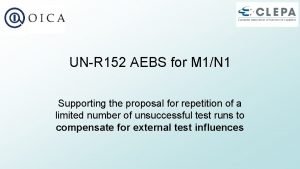
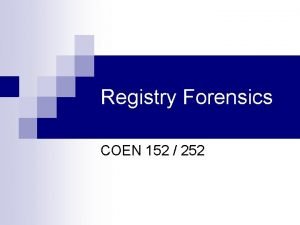
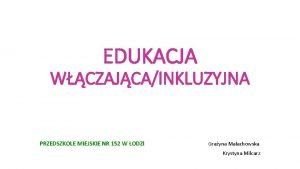
![Law society of tasmania v richardson [2003] tassc 9 Law society of tasmania v richardson [2003] tassc 9](https://slidetodoc.com/wp-content/uploads/2020/10/1024173_0ab07c7fa5fe15bbad1bb1a43f32eeb0-300x225.jpg)

